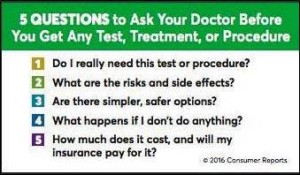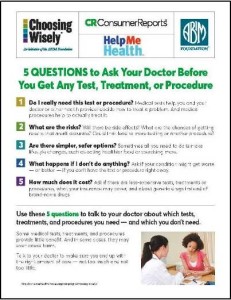
Editor’s Note: This week, we revisit and update a post from one year ago. In the original post, Randi Oster relates a personal story to illustrate the value of the Choosing Wisely campaign. Sponsored by Consumer Reports and the American Board of Internal Medicine Foundation, Choosing Wisely helps patients navigate medical decision-making by providing information about tests, treatments and procedures that under some circumstances may be wasteful or cause harm. Choosing Wisely works together with providers to engage patients and families in discussions about deciding which options are right for them. Choosing Wisely celebrated its fifth anniversary earlier this year with a special report that provides a brief history and highlights the leadership of organizations and individuals who have championed the engagement and education of consumers through this program.
The Patient Perspective
I brought my 79-year-old dad to the emergency room because to me it looked like he’d had a stroke. He could not hold up his Carvel ice cream cup, and his mouth was drooling and sagging. After 11 hours of waiting in the ER and undergoing a CT scan, an attendant brought him up to a room. The diagnosis was a brain tumor called a glioblastoma. It is like tree roots growing throughout the brain. All I wanted was for my father to be fine.
With my father sitting in his hospital bed, he told me he just wanted the facts about his prognosis and asked me to help him get them. My mom just held his hand and tried to hide her tears, as I stared at them both in a daze. My cell phone rang and brought me back to my work reality. It was my manager. She, too, had been through medical emergencies, and in unemotional corporate speak, she told me the best advice ever. Randi, the doctors will only answer the questions you ask. They will not give you more information than you request. Don’t be afraid to ask the hard questions.”
Are You Listening?
As I hung up the phone, a young resident surgeon from an Ivy League school was meeting with my father, telling him that they’d scheduled brain surgery for the next day. The caliber of her education meant to me that she knew surgery was the best next step; otherwise wouldn’t we be discussing other options?
All day my dad kept saying he wanted a “minimally invasive approach” and did not want chemo and radiation. He kept saying this to anyone who’d listen, but no one seemed to be listening, including me. Finally, as what seemed like a last resort, he asked “Can you please find out what the surgery entails?”
Asking the Hard Questions
I grabbed a tissue and stepped out into the hall. I shut my dad’s hospital room door and braced myself against the wall for support, and there, in the narrow hallway of the hospital, took my boss’s suggestion to ask the hard questions. I blurted out to the doctor, “How long will he live without surgery and how long with surgery?”
“Eight weeks without surgery and eight months with surgery,” the doctor answered. He then continued with the fine print speech. “There is a very good chance with brain surgery he could experience some paralysis on one side of his body. He might have trouble speaking. He probably won’t see colors. Also, he’d still need chemo and radiation. He’d be home with the family so you could provide care at home, take him for treatments, and help him with pain from surgery.”
That is exactly what my dad wanted to avoid. Why would they have scheduled this surgery without listening to him? I wondered.
What the Doctor Ordered
Asking the hard question first really told me the critical information: eight weeks versus eight months. “So,” I said, “without surgery he could go home, have no additional pain, meet with his friends and family and slowly deteriorate. He will eventually fall asleep and not wake up. With surgery, he could be a vegetable, but maybe not. But he definitely will have pain and need aftercare, starting tomorrow?”
“Yes, but don’t forget — he’ll also have time for one last cruise,” the doctor said, sounding like a salesman to me. One last cruise reverberated in my head. My father should go through all of this pain for one last cruise? In the couple of minutes the doctor spent with my dad, he clearly did not know him. After the Navy, my dad never wanted to go on a ship again.
What the Patient Wanted: Living and Dying with Dignity
We took my dad home. At the beginning, he was fully mobile. I invited his friends and relatives to the house, and we spent the weekends laughing over old photo albums. He had time and brain capacity to impart all his life wisdom to me.
As the days progressed, he lost movement in his legs. He needed assistance peeing. He needed care 24/7. Between my husband, my Mom and I, we all did shifts. We kept him home until we were unable to care for him and then visited him in hospice every day.
On the fifth day, he was close to the end and still without pain. My mom and I decided not to leave his side. We sat in the room reading magazines and chatting, and sometimes our reminiscing even made us laugh. At one point, I looked over at my dad at saw a slight smile. He took one last inhale as my mom and I kissed him and told him we loved him. And as we said our final good-bye, I felt overwhelmed with gratitude. My father, Eugene Victor Redmond, lived and died with no pain but with complete dignity.
Empowering Patients to Ask Questions

This convenient wallet card empowers patients to ask the tough questions and provides a basis for shared decision making.
Sometimes the best medical option is not the patient’s preference. Family doctors know that many patients get unneeded prescriptions. Obstetricians know that too many babies are delivered by C-section. Radiologists have seen a lot of pointless chest X-rays. blood tests, EKGs, Pap tests and MRIs all are overused.
In fact, when doctors sit down with the medical evidence within their specialties, hundreds of tests and treatments turn out to be frequently unnecessary, duplicative or even harmful.
For the U.S. health system as a whole, it means 30 percent of medical spending is wasted.
Smarter, Safer, More Effective Care
For patients? It means their time, energy and money could have been focused on smarter, safer, and more effective care. With limited appointment time, it is critical to help patients and doctors talk about what’s truly needed. The ABIM Foundation has joined with more than 70 medical specialty societies to develop evidence-based lists of tests and procedures that should be questioned. The program is called Choosing Wisely.
As a partner in that effort, Consumer Reports has created more than 120 free brochures for patients and their families, addressing the most common of these concerns. There is also free posters, videos, rack cards, and wallet cards that help people ask their healthcare providers the right questions.
How to Start a Choosing Wisely Campaign

Displayed in the waiting room, this poster empowers patients, inviting them to have a meaningful discussion with their provider.
The most effective and efficient way to start a Choosing Wisely campaign: Start with the fundamentals.
Hang the 5 Questions Poster in waiting rooms and exam rooms, post it on your website and intranet, email it to everyone, or hand out printed copies.
More Ways to Share the 5 Questions:
Go to the Consumer Health Choices website to gain access to useable information.
- Show the 5 Questions Video on TV, in waiting and exam rooms, and in employee lounges.
- Distribute the 5 Questions Wallet Card at health fairs, lunch ‘n learns, and town halls.
Another successful way to reach consumers early in your campaign: Each month, highlight one of the Choosing Wisely topics via e-newsletters, social media, work intranet sites, and more. Consider topics such as overuse of antibiotics for a runny nose as the school year kicks off or overuse of Lyme disease testing in spring and summer.
Respecting What Patients Want
I didn’t have the wallet card with me when my dad was hospitalized. I was scared to ask questions. I wish I knew it was OK to ask these questions. I did speak up and my dad made the right decision for him. Now, I hope everybody can benefit from asking these five questions. It is about healthcare and when we care about what the patient wants, they become empowered patients with realistic expectations.




